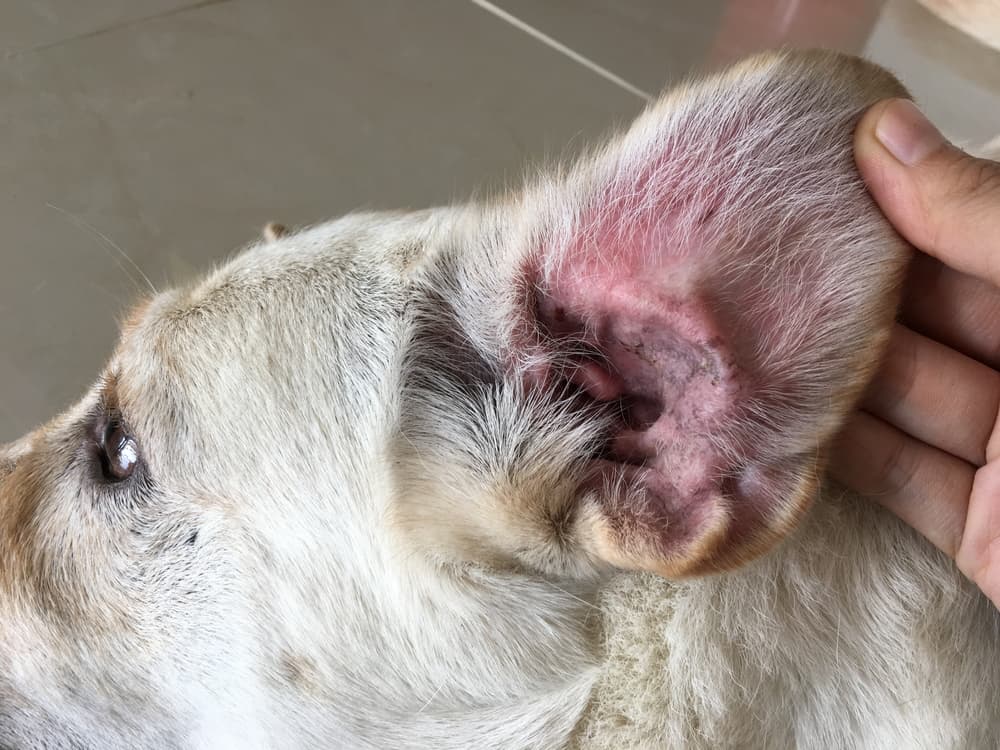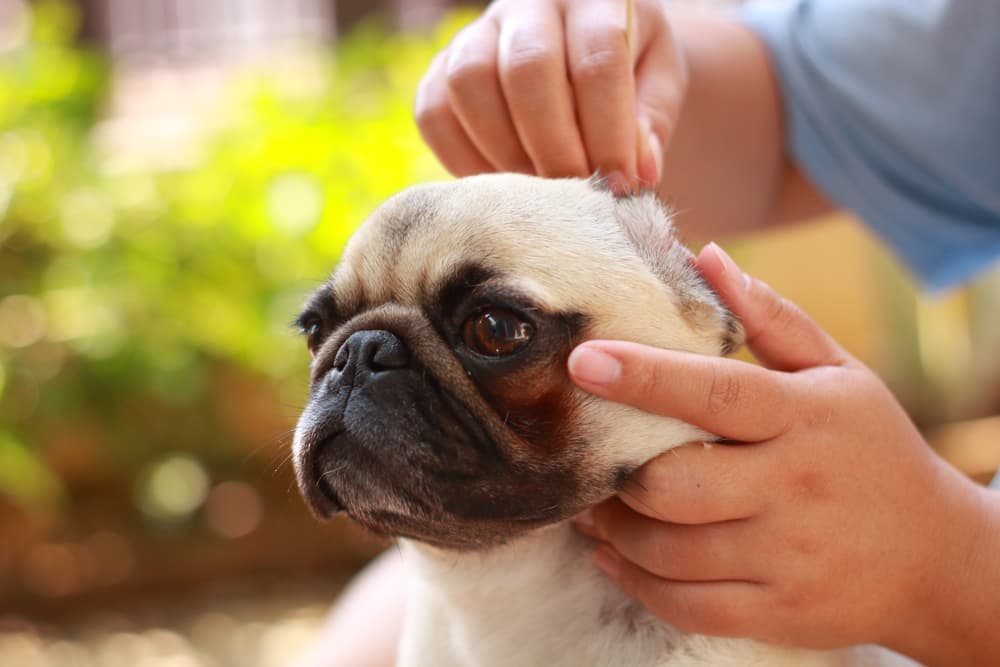All the Reasons Your Dog’s Ears Smell

You’ve given your dog one bath after another but there is still a persistent odor. You can’t seem to figure out where it’s coming from until you finally pinpoint the problem—it’s his ears.
Your dog’s ears look clean when you inspect them. So now you’re wondering, “Why do my dog’s ears smell?”
Normally, dog ears do not have an odor. But smelly ears are a common problem most pet parents experience.
Dog Ear Anatomy: A Quick Overview

A dog’s ear canal is made up of three parts: the external, middle, and inner ear. The external ear—the part of the ear we can see—is called the pinna and protects the inner parts of the ear that house the important structures our dogs use to hear.
Important nerves and blood vessels also run through the inner part of the ear and must be protected. Diseases of the ear can compromise these structures and cause permanent damage. This is why keeping your dog’s ears as healthy as possible is so important.
Why Do My Dog’s Ears Smell?

Inflammation of any parts of the inner ear in dogs can cause irritation and lead to changes that cause a malodorous smell. Sometimes the smell is foul—like garbage or morning breath. Other times, it may smell pungent like cheese or sweet like caramel.
Ear infections are the most common culprit of smelly ears in dogs, but can occur for many different reasons. Infections are most often caused by bacteria or yeast and often occur secondary (or in response to) a primary factor.
Signs of ear infections in dogs include:
- Pain
- Itchiness
- Redness
- Discharge (with or without an odor)
- Rubbing ears on the ground or furniture
Some dog breeds, such as those with floppy ears, hair in the external ear canals, and narrow ear canals, are more likely to have smelly ears than others. Dog breeds more susceptible to ear problems and ear odors include Bulldogs, Spaniels, Retrievers, Terriers, and Poodles.
Below are some common reasons your dog’s ears may smell unpleasant.
Bacterial Ear Infections
These types of ear infections usually involve more than one type of bacteria. These bacteria can cause ears to smell sweet like grapes or caramel or rancid like rotten chicken or bad breath. Dogs with bacterial infections in their ears may rub their ears on the ground or on furniture to relieve itchiness. Bacterial ear infections often have white or yellow discharge. Other signs include head shaking or tilting and shying away from having their ears touched.
Yeast Infections
Smelly yeast infections in a dog’s ears are caused by Malassezia, a type of yeast. You might smell an odor similar to bread baking or beer. These types of ear infections are the itchiest for dogs. You may notice your dog rubbing his ears along the floor or scratching intensely at them. Yeast ear infections often have dark brown discharge.
Allergies
Allergies are another very common cause of ear infections and odors in dogs— responsible for almost half of ear infection cases. Your dog may be allergic to something in the environment such as pollen or food; come into contact with an irritating substance; have generalized allergies, or experience a local drug reaction. Infections caused by allergies may not have a smell or may take on the smell of a yeast or bacterial infection.
Common signs of allergies include ears that are red or warm to the touch, rubbing ears along the floor or scratching at ears, discharge from the ears or sores/scabs on the ear. For severe or chronic cases, the ear canal may become firm and thickened.
Ear Mites
Ear mites are tiny and hard to see with the naked eye. Otodectes cynotis, Demodex, and Sarcoptes are the most common ear mites in dogs. They are very itchy and uncomfortable for dogs. Oftentimes, you will see build up in your dog’s ears that resemble coffee grounds. This build up can cause your dog’s ears to smell foul, but not rancid. This smell is usually similar to old trash.
Ear mites should be treated immediately as they are able to spread from dog-to-dog. You might notice signs similar to ear infections such as ear scratching, head shaking, redness and head tilting.
Foreign Objects
Surprisingly, it’s not uncommon for dogs to get things in their ears that don’t belong there. Plant awns, hair, grass seeds, or anything else your dog may have gotten into can end up in their ear. Your dog may also develop a mass or growth in his ear. Growths, polyps, or enlargement of the glands that secrete ear wax can also create the same trouble.
Changes like these decrease ventilation to the ear. The ear canal cannot dry properly and humidity within the ear canal increases, which favors overgrowth of yeast and bacteria.
Your dog may be more likely to get things stuck in his ear during the summer months. You may see him scratching his ears, shaking his head and—depending on where the object is—there may be a small amount of blood.
How to Treat Smelly Dog Ears

You should see your veterinarian in order to resolve the smell coming from your dog’s ears. Long-term ear infections can lead to a rupture of the eardrum and consequently a loss of hearing.
Your veterinarian will do a number of things to obtain an accurate diagnosis of why your dog’s ears are so smelly.
First, your vet will use an otoscope to examine the inside of the ear. Here the veterinarian will be able to see redness, discharge, or a mass or foreign object inside your dog’s ear.
During the exam, your veterinarian may also take a swab from your dog’s ear to examine under the microscope. This will show whether your dog has mites, bacteria, or yeast in his ears. Bacterial cultures are necessary for dogs whose ear infections have not responded to previous treatments in order to choose the most effective antibiotic.
Further diagnostics such as radiographs, computed tomography (CT) or magnetic resonance imaging (MRI) may be necessary to examine the extent of disease in your dog’s ear.
Surgery may be recommended for certain diseases such as chronic ear infections or masses.
Medications to Treat Ear Infections in Dogs
Your veterinarian will prescribe either topical medications (such as ear drops for dogs) or systemic treatment (usually given orally) depending on the severity of your dog’s symptoms.
The most common topical treatments are combination products that contain a steroid to decrease inflammation and itchiness, an antibiotic, and antifungal to control the infection.
In the case of ear mites, medications such as ivermectin, selamectin and moxidectin can be used to kill the parasites.
How to Clean a Dog’s Ears

Ear cleaning is an important step in treating and preventing ear infections—and ear odor—in dogs.
Debris in the ear canal can inactivate some topical medications and prevent medications from reaching the ear canal. Debris can also protect microbes and retain bacterial toxins that worsen infection.
When cleaning your dog’s ears, it’s important to prepare your area and set up all of your supplies beforehand. Make sure that you have:
- A small, easy-to-clean location in which to clean your dog’s ears (such as a bathroom, laundry room, or even your back porch)
- A tasty treat to reward your dog (peanut butter works great!)
- Dog ear cleaning solution
- Cotton balls or tissues
- A towel
While many pet parents view ear cleaning as a chore that they should “push through,” the best way to clean your dog’s ears is to make it enjoyable. This can alleviate a lot of stress for both you and your dog.
Here are some steps for ear-cleaning success, shared by Catherine Barnette, DVM:
Step 1: Select a quiet location that is free of distractions and easy to clean up. Ensure that your dog can’t get away from you, because chasing your dog around your house is a surefire way to increase everyone’s stress level!
Step 2: Place a tasty treat in an area where your dog can eat it as you’re cleaning the ears. If you’re in the bathroom, for example, consider placing a long trail of peanut butter along the side of the bathtub. You could also place peanut butter or dog-safe cheese spread on a treat dispensing mat like the Aquapaw and stick it to the bathtub. Eating the treat will distract your dog from the ear cleaning and encourage him to hold still.
Step 3: Lift your dog’s ear flap (the pinna) and squirt dog ear cleaner into the ear. The amount of cleaner that is required will vary between dogs, but your goal is to fill the ear canal until the cleaner is about to overflow out of the ear.

Step 4: Massage the base of the ear gently (about 60 seconds). You should hear a “squishing” sound as the ear cleaner works its way throughout the ear canal.
Step 5: Let go of your dog’s ear. In most cases, your dog will shake at this point, which forces wax within the canal to rise up to the surface of the ear (due to centrifugal force).
Step 6: Use a tissue or cotton ball to clean out the wax that has risen to the surface of the ear. Note: Don’t use cotton swabs, which can push debris further into the ear and even injure your dog’s eardrum.
Step 7: Repeat as needed, until you are no longer removing a significant amount of debris from your dog’s ear.
Step 8: Perform the same process on your pup’s other ear.
Step 9: Use a towel as needed to dry your dog’s ears and coat.
Dog Ear Cleaning Tips

Commercial pet ear cleansers have compounds such as cerumenolytics and drying agents that soften and breakdown the ear wax, slow the growth of bacteria, decrease secretions, and reduce moisture.
If your dog’s ears have sores or scabs due from rubbing and scratching, you can try an over-the-counter wound care product to soothe the skin and promote healing.
How often you clean your dog’s ears will depend on a number of factors. For an average healthy dog, with no history of ear infections and no swimming, every 3-4 weeks is a good baseline.
If your dog has floppy ears and/or has recurrent ear problems, however, your veterinarian may recommend cleaning your dog’s ears on a weekly basis. More consistent cleaning can help keep the ears clean and dry and facilitate early detection of infections.
Dogs that spend a lot of time in the water should also have their ears cleaned frequently. Your veterinarian may recommend weekly ear cleaning or may recommend cleaning your dog’s ears after every swim.
Not cleaning prior to applying medicine and cleaning too much are the most common reasons for treatment failure in dogs with ear infections.
